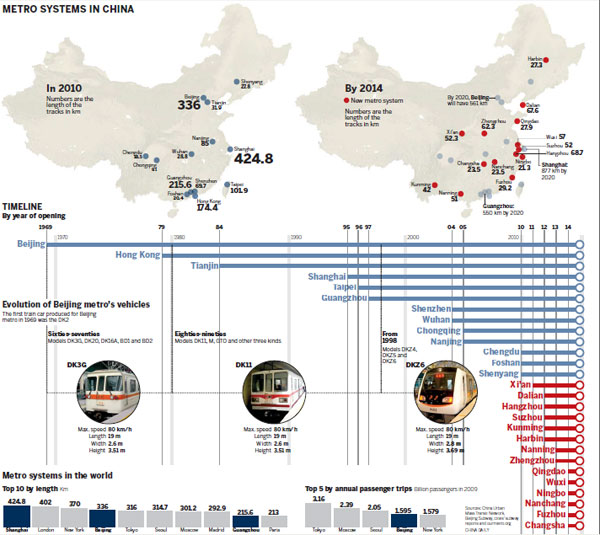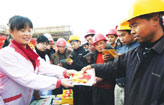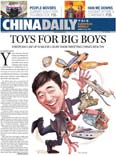Enter the people movers
Updated: 2011-04-15 12:30
By David Cohen (China Daily European Weekly)
For many planners, tackling Beijing's congestion will take more than building a better subway. Li says the underlying problem was the concentration of government, universities, and companies in Beijing's relatively small historic core.
Beijingers, he says, must travel farther each day than their counterparts in other major cities, such as New York and Tokyo, making painful commutes all but inevitable. A commuter living at Nanshao, at the end of the new Changping line, for example, would need over an hour just to get on board Line 2, the circular line that circumnavigates the city center.
Long trips are also making it harder for Beijing commuters to use bicycles, once the main form of transport in most Chinese cities. Zhou says bicycles and bicycle lanes were being crowded out by the proliferation of private cars, which more than doubled in Beijing during the past 10 years.
"In Europe," he says, "the bicycle is coming back, but in China, we are losing bicycles, especially in the last decade. We are losing bicycle lanes."
 |
Li says that the subway system now serves less than half of Beijing's residents. In recent studies, his department found that half of all trips in Beijing are taken in private cars, making congestion worse than in larger cities, even those with more cars.
"Right now, Beijing doesn't have a very good public transport system. The number of cars in Tokyo is much higher than Beijing, 8 million as opposed to 5 million, but in Tokyo, 90 percent of commuters take public transit."
Experts are more optimistic and confident that Beijing can eventually "build out" of its current crisis, using a combination of new approaches to transportation now being tried in cities around China, and, changes to the way space is used in Beijing.
But, Li says, the process will be difficult and slow.
"Don't put your expectations too high, no way the problem can be solved in a few years," he says. "People will suffer, even as we fix the problem, and have to change their lifestyle, for sure."
First on the list is reversing the trend toward driving to work. Doing so, Zhou says, is more than just an engineering problem. In order to create new bike lanes or routes for bus rapid transit, a system that gives long-distance buses their own lanes in order to speed their travel through heavy traffic, planners will have to take room away from cars.
"Surface transportation is often political," he says. "Politically, decision-makers don't want to allocate surface to public use over private."
In the past year, the city of Beijing has begun trying to get cars off the roads, putting strict rules on car ownership and licensing. Residents without Beijing hukou or household registration are no longer allowed to drive their cars within the city limits.
Bus Rapid Transit (BRT) systems and programs to encourage bicycling have also been gaining traction in dozens of Chinese cities, says Karl Fjellstrom, vice-director at the Institute for Transportation and Development Policy (ITDP), a multinational NGO that advises the city of Guangzhou on transportation issues.
Guangzhou's network of BRT lines and bicycle-sharing programs is serving as a model for Chinese cities struggling with traffic.
The key, experts say, was integration. The BRT lines carry 800,000 people a day. The city's bicycle-sharing system, Fjellstrom says, extends the reach of public transportation, allowing people who live farther from stations to get on board buses and trains quickly, and new tree-lined bicycle lanes help to make bicycles safe and appealing.
Residents can take a bicycle with the swipe of a transport card and ride it free for an hour, returning it to another station.
The convenience of shared bicycles can draw commuters away from their cars. According to a survey conducted by the ITDP, 75 percent of users on the bike-sharing system didn't use bicycles before the system opened.
Both concepts are spreading quickly in China. The World Bank has issued grants to 19 Chinese cities to build BRT networks, and Fjellstrom says his organization is advising dozens of other cities on starting similar programs. Hangzhou has already built the world's largest system, with 500,000 bikes collectively used nearly 2 million times a day.
Beijing has established four BRT lines, and Li says that more will open once plans have been completed to link lines to subway transfer stations.
Eventually, the experts interviewed all agree: It will be possible for Beijing to overcome congestion through a combination of new technology and changing habits, encouraging the use of bicycles and public transit and encouraging employers to move to suburban office parks to diffuse the crush of commuters entering the city center.
"The new subway system is going outside, and that's basically the direction for the city," Li says.
E-paper

Han me downs
Traditional 3,000-year-old clothes are making a comeback.
Reaching out
Fast growth fuels rise in super rich
Chinese tourists spend more
Specials

Big spenders
More mainland tourists are expected to spend money on overseas travel this year.

Rise in super rich
Report cites rising property prices, gdp as key drivers of increasing number of chinese millionaires.

Reaching out
Condom makers are stepping up their presence in smaller cities to boost sales
